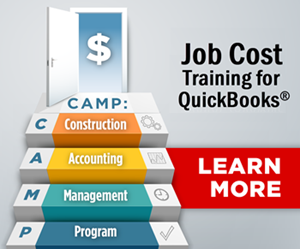How to use QuickBooks most effectively can be a challenge. But, to help you, here are a series of QuickBooks “how-to” tips from BuildYourNumbers.com!
How To Use QuickBooks
Do you use QuickBooks to manage your accounting?
 For years, mid-sized and small-business owners have found QuickBooks Desktop, QuickBooks Online, and Enterprise Solutions to be the most economical, efficient, and flexible programs for in-house accounting.
For years, mid-sized and small-business owners have found QuickBooks Desktop, QuickBooks Online, and Enterprise Solutions to be the most economical, efficient, and flexible programs for in-house accounting.
Yet these businesses are often not using their accounting software program to its fullest potential…
QuickBooks is a great asset. The information it can deliver will provide the insights you need to increase your productivity (and profits!).
How To Use QuickBooks More Effectively – 10 Tips
-
“Begin with the End in Mind” by Using a Pencil Copy or Spreadsheet Layout
As you’re learning how to use QuickBooks, remember that – just as in construction – the underlying design and structure will have a huge impact on your final results! If you’re just beginning or want to remodel your current accounting system:
- Start with a working copy of your accounts and lists so that you can establish exactly how you want your QuickBooks to act.
- A spreadsheet can also be a useful way to sort, organize, and group various elements while you are still brainstorming….
-
Review & Set Your Company Preferences in QuickBooks
QuickBooks allows you to modify your Company Preferences for the structure of data, reports, and features that you do and don’t want to use. Make selections that reflect the way that your company does business..
-
Learn How To Use QuickBooks’ Lists Feature
QuickBooks’ lists help integrate information and minimize data-entry chores. Using those lists creatively also allows you to customize reports and get the information you need to make management and pricing decisions..
-
Use QuickBooks’ Chart Of Accounts To Group Your Costs By Business Function
Use your Chart of Accounts to group costs by business function. This step will provide you with instant information on costs from a control and decision-making perspective.
-
Use QuickBooks Customer:Job List Function
The Customer:Job feature is designed to help you track all financial transactions that apply to a specific customer. This allows you to assign estimated costs, purchase orders, bills, employee time, payments, etc., to each job.
You can also organize names in a variety of ways in order to provide useful summaries and analysis.. -
Create Unique Vendor Names
QuickBooks allows you to create unique vendor names. This means that you can quickly enter vendors and auto-recall cost assignments while still using the vendor’s formal name for payment..
-
Learn How To Use QuickBooks Reports and Customize Them To Meet Your Needs
Company owners, individual departments, and accountants all require different reports, formats, and processes. Once you recognize what those individual needs are and understand how to use QuickBooks’ systems, you can customize reports to meet your company’s varied needs.
-
Use QuickBooks to Monitor Important Information
QuickBooks allows you to establish accounts and items that will gather and report on the information that is important to you. For example, you could add a “Direct Labor-Overtime” account and payroll items. Then, you can quickly see and monitor direct labor overtime costs – in total, by job, or by employee.
-
How to Use QuickBooks Help Features
QuickBooks includes these onscreen help features:
- Help With This Window: Press F1.
- Help Index: In the Help window, highlight and click on a relevant word to see definitions, further explanations, examples, and related topics.
- How Do I?: Found in the activity windows. Click the “How Do I?” button, and a drop-down menu will appear. Just select the answer to your question.
-
Get Efficient! Learn How To ‘Maneuver’ QuickBooks Like an Expert…
For example, learn which navigation methods work best for you. For instance, you can choose from:
- Navigation windows
- Pull-down menus
- Icons
- QuickBooks Centers
- Shortcut keys
![]()
People Also Ask
FAQs (Frequently Asked Questions)
1. How can I start using QuickBooks more effectively?
Begin with a pencil copy or spreadsheet to design and outline your accounts and primary structural Lists. For example, consider Lists for Items (cost codes), Customers and related Jobs, Customer Types, Classes, and so on. These Lists establish how you want your QuickBooks to function and what you will see on your reports.
2. Why is it important to set my Company Preferences in QuickBooks?
Setting Company Preferences tailors how various features within QuickBooks will function to meet the specific needs of your business.
3. What are QuickBooks Lists, and why should I use them?
Each QuickBooks List performs a specific function, while the Lists also integrate various aspects of the data you enter so you can see meaningful results. When properly structured, Lists help eliminate duplicate data entry, minimize external data-crunching in spreadsheets, and set the stage to create customized reports. Information tailored to meet your needs means you’ll be able to rely on your data to make better management decisions.
4. How can I use the Chart of Accounts effectively in QuickBooks?
Group costs by business function to instantly see reports that show subtotals for dollar amounts and percentages of income. Use these summarized results for cost control and management decisions.
5. What is the Customer:Job list feature, and how does it help?
This feature means you’ll be able to track financial transactions related to specific Customers as well as the Jobs performed for those Customers. Customers and Jobs are designed so you can see reports that show the results of income and costs for Customers and Jobs.
6. Why create unique vendor names in QuickBooks?
When you create “unique vendor names” for different types of transactions to one vendor, you can use those variations to the vendor’s name to “program” the QuickBooks auto-recall feature. When the nature of the transaction for the vendor changes, you will be able to select the “unique vendor name,” which automatically assigns the correct accounts. Voila! You won’t have to select between different Accounts or Items. This means you can streamline data entry while still using the correct vendor names for outgoing payments.
7. How do I customize QuickBooks reports to meet my needs?
Make various selections within the “Customize” option shown at the top of your reports. As you recognize the reporting needs of different users, you can use this menu to customize reports to provide relevant information to different readers.
8. What information can I monitor using QuickBooks?
QuickBooks allows monitoring of nearly every important metric within the financial life of your company! You’ll find that you can monitor assets, liabilities, owners, like direct labor overtime costs by job or employee, providing valuable insights for management.
9. How can I use QuickBooks help features effectively?
Utilize on-screen help features from the Menu bar like Help > QuickBooks Desktop Help/Contact Us, With This Window,” “Help > Contact Us,” and “Help >Ask Intuit.” You can also press (F1) and “How Do I?” buttons for immediate assistance and detailed explanations.
10. What are the best navigation methods in QuickBooks?
QuickBooks offers a multitude of ways to navigate. For example, you can use the Home screen navigation window to click through to nearly any activity. Within Lists, there are “right-click pull-down menus” (also available at the bottom of Lists), Icons, “Centers,” choices and drop-down menus at the top of the screen, and embedded shortcut keys to help you become more efficient.
Additional resources and guides are available on the Build Your Numbers website.
![]()
“How To Use QuickBooks More Effectively and Efficiently”
Are You Ready To Learn Additional Tips & Techniques?
You deserve to have access to the management information that will help you run your company more profitably!
We love to teach business owners (and/or their bookkeeping staff) in-depth ways to use QuickBooks’ structure and features to meet their goals.
If you have the feeling that you could benefit from utilizing your QuickBooks Pro, Premier, or Enterprise Solutions at a higher level, take a look at our QuickBooks Desktop Training Subscription series, or contact us at 734-544-7620 (9-5 Eastern, M-F) with any specific questions you may have.
At Info Plus, we offer a wide range of affordable workshops and training specific to job costing using software such as QuickBooks® desktop and Excel. We love teaching and coaching, so if you’re ready to learn, we’re here for you.…

You can sign up for any of our workshops or training tutorials and learn what you need to know 24/7. If you’d like to learn more about the training, please send an email or call. We’ll be happy to explain how it works so you can decide if it would be a good fit for you and your business.
We look forward to hearing from you and learning more about how we can help…
Bonus: Want to Increase your Gross Profit? Here’s a useful one-sheet Excel calculator…

